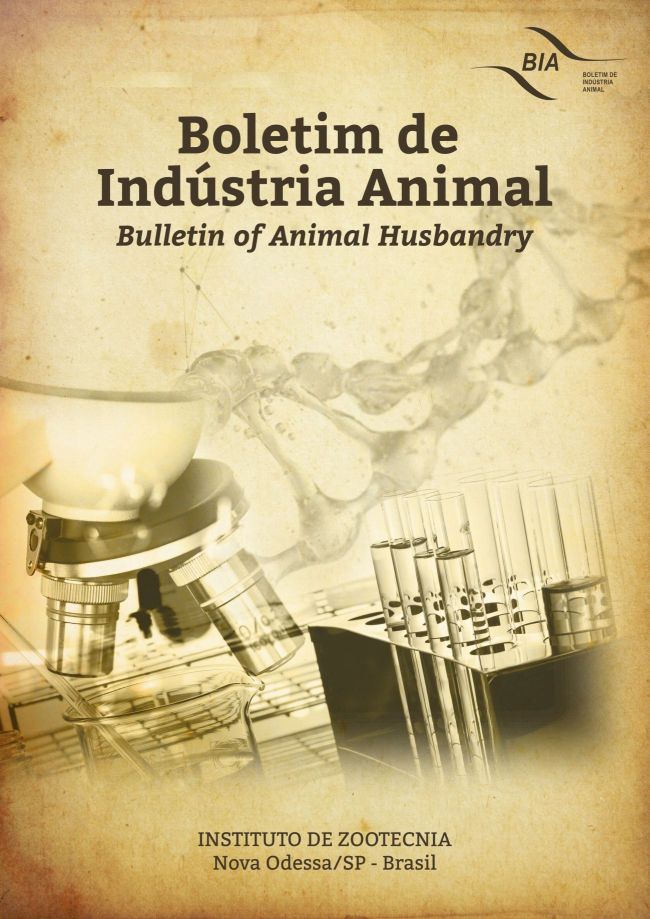Estrous synchronization and fertility of beef cows treated with melengestrol acetate and estradiol cypionate
DOI:
https://doi.org/10.17523/bia.2019.v76.e1452Keywords:
ECP, Caracu, Artificial Insemination, MGAAbstract
The objective of this experiment was to evaluate estrous synchronization responses and pregnancy rates of beef cows treated with melengestrol acetate (MGA) and estradiol cypionate (ECP). Forty lactating Caracu cows (a locally adapted Bos taurus taurus breed) grazing on Panicum maximum cv. Tanzania and supplemented with corn silage received the equivalent of 0.5 mg/animal/day of MGA for 14 days. On day 5, the animals were randomly assigned to one of two groups: group 1 (n=21) received an im injection of 2.0 mg ECP and group 2 (n=19) received 2 ml saline. Animals of group 1 that exhibited estrus within 120 hours after withdrawal of MGA were inseminated (AI), while animals of group 2 were treated with cloprostenol 17 days after MGA removal and were inseminated during induced estrus. In both groups, cows without estrus detection during the day stayed with a bull at night for possible mating. Pregnancy was diagnosed by ultrasound examination 40 days after AI. Chi-square analyses were used to detect differences between groups. Eight (38.1%) animals of group 1 and 7 (36.8%) of group 2 showed estrus after withdrawal of MGA (P>0.05). The conception rates in groups 1 and 2 were, respectively, 37.5% and 50.0% for inseminated cows and 58.3% and 64.3% for inseminated cows mated by the bull at night (P>0.05). These results suggest that it is possible to use the first estrus of females treated with ECP on day 5 of a 14-day MGA treatment. Furthermore, considering the large number of cows mated by the bull at night, it is recommended to use estrus detection tools as an aid for the identification of such animals or to combine AI and bulls for breeding.
Downloads
References
ABEL, J.M.; BISHOP, B.E.; THOMAS, J.M.; ELLERSIECK, M.R.; POOCK, S.E.; SMITH, M.F.; PATTERSON, D.J. Comparing strategies to synchronize estrus before fixed-time artificial insemination in primiparous 2-year-old beef cows. Theriogenology, v.87, p.306-315, 2017. https://doi.org/10.1016/j.theriogenology.2016.09.010
BÓ, G.A.; DE LA MATA, J.J.; BARUSELLI, P.S.; MENCHACA, A. Alternative programs for synchronizing and resynchronizing ovulation in beef cattle. Theriogenology, v. 86, p.388-96, 2016. https://doi.org/10.1016/j.theriogenology.2016.04.053
COLÉGIO BRASILEIRO DE REPRODUÇÃO ANIMAL - CBRA. Manual para exame andrológico e avaliação de sêmen animal. 3.ed. Belo Horizonte: CBRA, 2013.
CUSTER, E.E.; BEAL,W.E.; WILSON, S.J.; MEADOWS, A.W.; BERARDINELLI, J.G.; ADAIR, R. Effect of melengestrol acetate (MGA) or progesterone-releasing intravaginal device (PRID) on follicular development, concentrations of estradiol-17ß and progesterone and luteinizing hormone release during an artificially lengthened bovine estrous cycle. Journal of Animal Science, v.72, p.1282–1289, 1994. https://doi.org/10.2527/1994.7251282x
MARTINEZ, M.F.; KASTELIC, J.P.; ADAMS, G.P.; MAPLETOFT, R.J. The use of GnRH or estradiol to facilitate fixed-time insemination in an MGA-based synchronization Animal Reproduction Science, v.67, p.221–229, 2001. https://doi.org/10.1016/s0378-4320(01)00128-2
MELLO, R.R.C.; FERREIRA, J.E.; MELLO, M.R.B.; PALHANO, H.B. Aspectos da dinmica folicular em bovinos. Agropecuária Científica no Semiárido, v. 10, p. 1-6, 2014.
O'CONNOR, M.L. Heat detection and timing of insemination for cattle. Pennsylvania: Pennsylvania State University, 2016. 18 p., Extension Circular 402. Disponível em: https://extension.psu.edu/heat-detection-and-timing-of-insemination-for-cattle. Acesso em: 10 out 2019.
PATTERSON, D.J.; KIRACOFE, G.H.; STEVENSON, J.S.; CORAH, L.R. Control of the bovine estrous cycle with melengestrol acetate (MGA): a review. Journal of Animal Science v.67, p.1895–1906, 1989. https://doi.org/10.2527/jas1989.6781895x
SÁ FILHO, O.G.; PATTERSON, D.J.; VASCONCELOS, J.L.M. Development of estrus synchronization protocols using melengestrol acetate in Bos indicus cattle. Journal of Animal Science, v.87, p.1981-1990, 2009. https://doi.org/10.2527/jas.2008-1757
SÁ FILHO, O.G.; VALARELLI, R.L.; PERES, R.F.G.; HOE, F.G.H.; MENEGHETTI, M.; VASCONCELOS, J. L. M. Avaliação do uso do acetato de melengestrol (MGA® Premix) em vacas de corte. A Hora Veterinária, v.27, p.1-5, 2007.
SCOTT, P. Condition Score (BCS) in Beef Herds. NADIS. National Animal Disease Information Service, 2017, p. 1-5. Disponível em: https://www.nadis.org.uk/disease-a-z/cattle/condition-score-bcs-in-beef-herds/ Acesso em: 10 out. 2019.
THOMAS, J.M.; LOCKE, J.W.C.; BISHOP, B.E.; ABEL, J.M.; ELLERSIECK, M.R.; YELICH, J.V.; POOCK, S.E.; SMITH, M.F.; PATTERSON, D.J. Evaluation of the 14-d CIDR-PG and 9-d CIDR-PG protocols for synchronization of estrus in Bos indicus-influenced and Bos taurus beef heifers. Theriogenology, v.92, p.190-196, 2017.
VRASPIR, R.A.; SUMMERS, A.F.; HARE, D.O.; ROWDEN, L.D.; FUNSTON, R,N. Comparison of long-term progestin-based synchronization protocols on fixed-time AI pregnancy rate in beef heifers. (2014). Nebraska Beef Cattle Reports. 759. http://digitalcommons.unl.edu/animalscinbcr/759
Downloads
Published
Issue
Section
License
Os autores não serão remunerados pela publicação de trabalhos, pois devem abrir mão de seus direitos autorais em favor deste periódico. Por outro lado, os autores ficam autorizados a publicar seus artigos, simultaneamente, em repositórios da instituição de sua origem, desde que citada a fonte da publicação original seja Boletim de Indústria Animal. A revista se reserva o direito de efetuar, nos originais, alterações de ordem normativa, ortográfica e gramatical, com vistas a manter o padrão culto da língua e a credibilidade do veículo. Respeitará, no entanto, o estilo de escrever dos autores. Alterações, correções ou sugestões de ordem conceitual serão encaminhadas aos autores, quando necessário. Nesses casos, os artigos, depois de adequados, deverão ser submetidos a nova apreciação. As opiniões emitidas pelos autores dos artigos são de sua exclusiva responsabilidade. Todo o conteúdo deste periódico, exceto onde está identificado, está licenciado sob a Licença Creative Commons Attribution (CC-BY-NC). A condição BY implica que os licenciados podem copiar, distribuir, exibir e executar a obra e fazer trabalhos derivados com base em que só se dão o autor ou licenciante os créditos na forma especificada por estes. A cláusula NC significa que os licenciados podem copiar, distribuir, exibir e executar a obra e fazer trabalhos derivados com base apenas para fins não comerciais.













